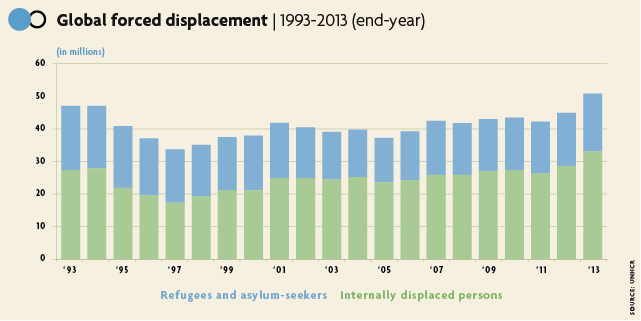
On Friday, June 20th the Office of the United Nations High Commissioner for Refugees (UNHCR) and nations around the world marked World Refugee Day with diverse tributes and activities. In its efforts to raise awareness about the struggles faced by refugees, UNHCR emphasized that the number of displaced persons in 2013 was the highest in the post-World War II era. [UNHCR: World Refugee Day]
World Refugee Day 2014
The United Nations General Assembly declared June 20th World Refugee day in 2001 as part of a resolution recognizing the 50th anniversary of the 1951 Convention Relating to the Status of Refugees. The United Nations established World Refugee Day “to honor the courage, strength and determination of women, men and children who are forced to flee their homes under threat of persecution, conflict and violence.” [ACHPR]
This year, world refugee day activities included a photo exhibition in Nepal, refugee film festival in Hong Kong, football (soccer) tournaments in Jordan’s Za’atari refugee camp, a fashion show in South Africa, and flash mobs in Venezuela. [UNHCR: World Refugee Day]
In Geneva, the UNHRC also released a mobile news app that provides up to date news about displacement in Arabic, English and French. The app also has sections that contain information about emergencies, key documents, and ways to help. The app, which is fully integrated with social media, is free to download. [UNHCR: News App]
Human Rights Bodies Call on States to Protect Refugees
At the regional level, both the Inter-American Commission on Human Rights and the African Commission on Human and People’s Rights marked the passage of World Refugee Day with public statements acknowledging the importance of protecting the rights and well-being of refugees and other displaced persons. [IACHR; ACHPR]
The Inter-American Commission recognized many Member States’ accomplishment in their efforts to protect persons who have been forced to flee their home countries, but expressed concern that “there are still countries in the region that have not adopted the norms and procedures that ensure the effective enjoyment of the right to seek and receive asylum or the principle of non-refoulement.” The Commission also acknowledged new challenges in the causes of migration and forced displacement in the Americas, such as natural disasters and violence on the basis of sexual orientation and gender identity. [IACHR]
The African Commission on Human and People’s Rights released a statement from the Special Rapporteur on Refugees, Asylum Seekers, Internally Displaced Persons and Migrants in Africa, who reminded States of their human rights obligations toward refugees in their territories. She also called on States “to draft domestic legislation on asylum and establish national institutions to protect refugees living in their respective territories” and contribute collectively to the cost of accommodating refugees in Africa. [ACHPR]
Raising Global Awareness
The UNHCR and supporters took World Refugee Day as an opportunity to raise awareness of the plight of refugees around the world. As a part of this effort, refugees and high profile supporters shared their stories through moving videos and personal accounts. Using social media, the stories have already reached more than 11 million people. [Thunderclap]
Celebrities and other supporters also helped to generate global attention and media coverage for World Refugee Day through activities that included visiting refugee camps, recording public service announcements, and using social media. Participants included UNHCR Special Envoy Angelina Jolie, Goodwill Ambassadors and former refugees Alek Wek and Khaled Hosseini, British author Neil Gaiman and many other actors, authors, musicians, and sports stars from around the world. [UNHCR: Stars bring UNHCR’s World Refugee Day Message]
Status of Refugees in 2013
According to the UNHCR’s annual Global Trends Report, internally displaced persons (IDPs) at the end of 2013 numbered approximately 51.2 million, an increase of more than 6 million from the beginning of the year. UNHCR, Global Trends 2013: War’s Human Cost (2014), p. 2, 23. This is the highest number of IDPs on record since comprehensive statistics were first recorded in 1989. Id. at p. 2.
The number of IDPs in 2013 included 16.7 million refugees. Id. Of this total, 2.5 million were new refugees. Id. at p. 5. The UNHCR also reported that children below the age of 18 made up 50% of the 2013 refugee populations. Id. at p. 3
The UNHCR report identified the ongoing conflict in Syria as the primary cause of the marked increase in the number of refugees worldwide. In 2013, the number of registered Syrian refugee children reached 1 million and the total number of Syrian refugees surpassed 2 million. Id. at p. 5.
In a statement on World Refugee Day, UN Secretary General Ban Ki-moon noted, “these rising numbers are a stark reminder of the international community’s inability to overcome its divisions to prevent and end conflicts.” While recognizing the important services provided by the UNHCR, he emphasized the urgent need for political solutions to world problems. [UN]
UNHCR
The Office of the United Nations High Commissioner for Refugees was established in 1950 with a mandate to “lead and co-ordinate international action to protect refugees and resolve refugee problems worldwide.” [UNHCR: About Us] With offices and staff in more than 125 countries, the UNHRC’s work is intended to help protect the rights and well-being of refugees around the world. The UNHRC also strives to aid asylum seekers and stateless persons. [UNHCR: About Us]
The UNHCR is currently led by UN High Commissioner António Guterres. [UNHCR: High Commissioner] The UN General Assembly and the Economic and Social Council (ECOSOC) govern the work of the UNHCR. [UNHRC: Governance]
For more information on asylum law and the human rights of refugees, see IJRC’s thematic research guide on Asylum & the Rights of Refugees.
